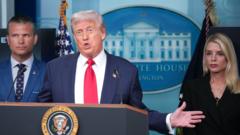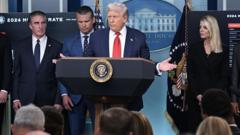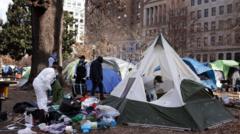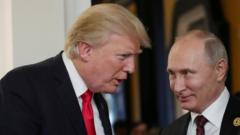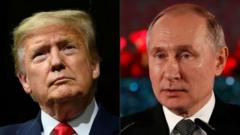This report explores contrasting views on crime in Washington DC, where President Trump claims that crime is "out of control," while local authorities assert a significant drop in crime rates. A thorough examination of the data reveals important insights into both violent crime and homicide rates, inviting broader discussions on public safety in the capital.
Analyzing Crime Trends in Washington DC: Claims vs. Reality

Analyzing Crime Trends in Washington DC: Claims vs. Reality
A comparative look at crime statistics in Washington DC amidst Donald Trump's assertions of rising violence.
President Donald Trump recently declared that crime in Washington DC is "out of control," pledging to send National Guard troops to restore order, slamming what he termed "crime, bloodshed, bedlam and squalor." However, Mayor Muriel Bowser claims that the city has experienced a substantial decrease in crime, citing the lowest violent crime rates in three decades.
Trump's comments came in light of his executive order declaring a "crime emergency" in the capital, with frequent references to rising violence. However, data from the Washington DC Metropolitan Police Department (MPDC) suggests a different narrative; violent offences peaked in 2023 but have since declined, with preliminary 2025 data indicating a 26% drop in violent crime compared to the previous year and a 28% reduction in robberies.
Despite this data, doubts about the accuracy of the crime statistics have been raised by both Trump and the DC Police Union. There are discrepancies between MPDC and FBI data on crime trends, with MPDC reporting a 35% decrease in 2024 while FBI reported a mere 9%. This inconsistency highlights the complexities of interpreting crime data based on methodologies and timelines.
Notably, Trump asserted that 2023 was a record year for homicides in DC, citing FBI data that notes a spike to around 40 homicides per 100,000 residents. While it was indeed a high point, it didn't reach the levels seen during the crime surges of the 1990s and early 2000s. The MPDC has reported a reduction in homicides in the following year, showing a 12% decrease compared to the same timeframe last year.
Carjackings have also been a focal point of Trump's statements, where he mentioned a more than tripling of incidents over five years. However, according to MPDC, this year has seen carjackings plummet to 189, down from 300 in the previous year. The rise in carjackings since 2020 has been acknowledged, but city measures like curfews for minors have been implemented to counter juvenile crimes, including carjackings, which typically escalate during summer months.
In comparing crime trends in Washington DC to other major US cities, while homicide rates are substantial, they still reflect a broader declining trend observed nationally. An analysis from the Council on Criminal Justice (CCJ) noted a 19% drop in homicide rates in the first half of 2025, while the average across 30 major cities was a 17% decline during the same period. However, the comparison of the first half of 2025 to pre-pandemic levels (2019) shows only a 3% decrease in homicides for DC, juxtaposed with a 14% drop nationally.
These conflicting perspectives on crime in Washington DC showcase the complexities rooted in interpreting crime data amid political narratives, raising essential questions about public safety, policies, and the reliability of crime statistics in shaping public discourse.

